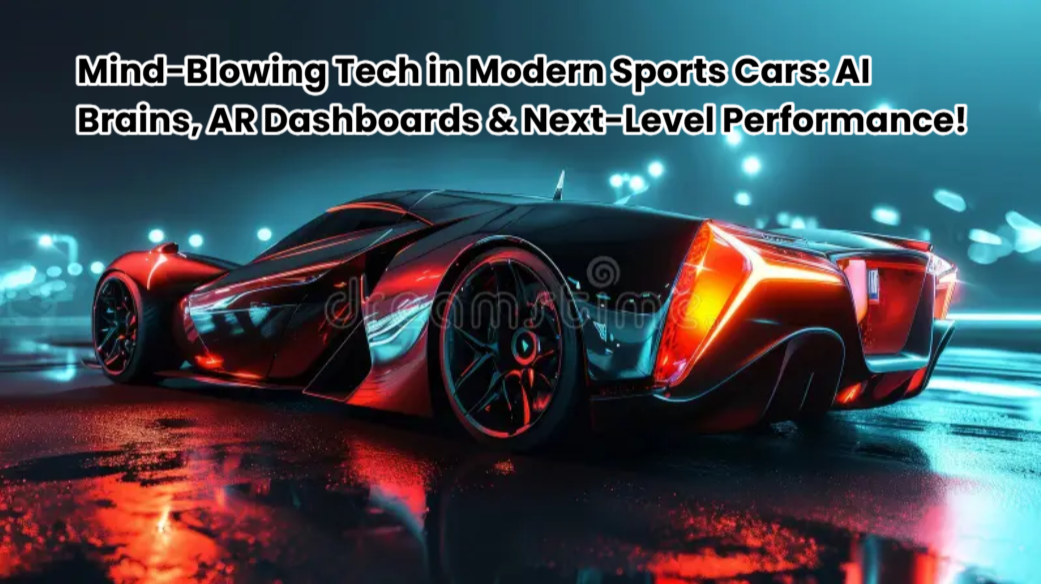We are on the brink of a new era. This is a time when the raw power of the internal combustion engine meets the smart capabilities of artificial intelligence. The modern sports car isn’t just a machine anymore. It’s a smart partner, a tech wonder that enhances our senses and makes driving even better.
The Dawn of the Digital Driver: A Human-Centric Perspective
For generations, the sports car has been a symbol of freedom, a vessel for adventure, a conduit for pure, unadulterated joy. It’s been about the wind in your hair, the roar of the engine, the visceral connection to the road. But now, a new dimension has been added, a digital layer that enhances and enriches the driving experience.

Artificial Intelligence: The Mind of the Machine, the Heart of the Driver
Let’s begin with artificial intelligence, or AI. It’s a term that often evokes images of robots and self-driving cars, but in the realm of sports cars, AI is about collaboration, not replacement.
- The Intuitive Co-Pilot: Building Trust and Understanding:
- Imagine having a co-pilot who anticipates your every move, who understands your driving style, who knows the road as well as you do. That’s the promise of AI in modern sports cars.
- It’s about building trust, about creating a symbiotic relationship between human and machine. The AI learns your preferences, your habits, your reactions. It becomes an extension of your own senses, a silent partner that enhances your abilities.
- The nuance of AI learning is very important, because no two drivers are the same. Each AI will have a unique personality based on the drivers habits, and the types of roads that the car is driven on. This creates a very personal experience.
- Performance Optimization: Pushing the Limits, Safely:
- AI is changing how we optimize performance. It helps drivers push their limits with more confidence and safety.
- It looks at large data sets in real-time. Then, it adjusts vehicle dynamics, traction control, and stability control. This helps to maximize grip and handling.
- It’s about finding the perfect balance between power and control, between adrenaline and safety.
- AI can also learn track information, and driver tendencies, to make the car faster over time. This creates a unique experience where the car gets better, as the driver gets better.
- Predictive Safety: Anticipating the Unexpected:
- AI is also enhancing safety by anticipating potential hazards before they materialize.
- It looks at sensor data, road conditions, and traffic patterns. This helps predict possible collisions and gives timely warnings.
- It’s about creating a proactive safety net, a guardian angel that protects us from the unexpected.
- This is especially important in high speed driving, where reaction times are critical.
- The Emotional Intelligence of AI: Understanding the Driver’s State:
- Beyond technical data, AI is also beginning to understand the driver’s emotional state.
- Biometric sensors can track heart rate, breathing, and eye movement. They detect signs of fatigue, stress, or distraction.
- The car can then adjust its settings, provide alerts, or even suggest a break, ensuring that the driver remains safe and alert.
- The car can also adjust the cabin environment, and even the cars performance to accommodate the drivers mental state.
Augmented Reality: A Window into the Future, a Bridge to the Present
Augmented reality, or AR, is changing how we see our world. It blends the physical and digital together smoothly.
- The Immersive Dashboard: Information at a Glance, Without Distraction:
- Picture a dashboard that shows information right on the windshield. It gives you important data while keeping your eyes on the road.
- That’s the promise of AR dashboards. Navigation directions, speed limits, performance metrics, all displayed in your line of sight.
- It’s about creating a driving experience that is immersive and easy to understand. This design reduces distractions and helps drivers focus more.
- The ability to see the optimal racing line on a track overlayed onto the real track is a game changer for performance drivers.
- Enhanced Navigation: Guiding You Through the Unknown:
- AR navigation systems show turn-by-turn directions on your real-world view. This helps you follow complex routes more easily.
- It’s like having a virtual guide, a digital co-pilot that leads you through unfamiliar territory.
- AR can also highlight points of interest, revealing hidden gems and scenic viewpoints.
- Situational Awareness: Seeing Beyond the Limits of Perception:
- AR improves situational awareness by showing potential dangers that the driver can’t see directly.
- It can highlight pedestrians, cyclists, and other obstacles, providing an extra layer of safety.
- It’s about expanding our perception, allowing us to see beyond the limits of our natural senses.
Advanced Sensor Technology: The Eyes and Ears of the Machine
AI and AR rely on advanced sensor technology. This tech helps the vehicle understand its surroundings well.
- Lidar and Radar: Mapping the World in 3D:
- Lidar and radar sensors make detailed 3D maps of the area around the vehicle. This helps advanced driver assistance systems and supports future self-driving technology.
- They provide a 360-degree view of the environment, detecting objects at great distances and with high accuracy.
- These systems are constantly improving, and becoming more accurate, and robust.
- High-Resolution Cameras: Capturing Every Detail:
- High-resolution cameras give clear visual details. They help with object detection, lane recognition, and other computer vision tasks.
- They capture every detail of the surrounding environment, providing a rich source of data for AI algorithms.
- These cameras also allow for advanced facial recognition, and driver monitoring, to enhance safety.
- Sensor Fusion: Combining Data for a Complete Picture:
- The true power of sensor technology comes from sensor fusion. This process combines data from different sensors. It creates a fuller and more accurate view of the vehicle’s surroundings.
- Sensor fusion algorithms help overcome the limits of single sensors. They offer a stronger and more dependable view of the driving environment.
- This also creates a redundancy system, that is very important for safety.
The Human-Machine Interface: Creating a Seamless Connection
The success of these technologies relies on a smooth and easy human-machine interface.
- Voice Control: Talking to Your Car:
- Voice control lets drivers talk to their cars. This hands-free method makes it easy to manage vehicle functions.
- It’s like having a conversation with your car, a seamless exchange of information and commands.
- Haptic Feedback: Feeling the Road:
- Haptic feedback gives touch sensations. It improves the driving experience by offering feedback without needing to look.
- It’s about feeling the road, feeling the car’s response, feeling the connection between human and machine.
- Gesture Control: Interacting with a Wave of Your Hand:
- Gesture control lets drivers use hand gestures to manage vehicle functions. This offers a modern and easy way to interact with their cars.
- The Emotional Connection: More Than Just Technology:
- The human-machine interface isn’t only about technology. It’s also about building an emotional bond between the driver and the car.
- It’s about creating a sense of trust, a sense of partnership, a sense of shared experience.
The Future of the Sports Car: A Technological Renaissance
New technology is changing the game for sports cars. Now, performance, safety, and personalization are key features.
- The Democratization of Performance: Bringing Technology to the Masses:
- Many technologies once reserved for high-end sports cars are now available to more drivers. This change makes performance accessible to a wider audience.
- The Connected Car: A World of Possibilities:
- Modern sports cars are becoming increasingly connected, enabling a wide range of new features and services.
- The Sustainable Sports Car: Performance Without Compromise:
- Electric sports cars use advanced battery technology. They show that performance and sustainability can go hand in hand.
- The Enduring Spirit: The Heart of the Sports Car Remains:
- Despite all of the technological advancements, the core spirit of the sports car remains unchanged.
- It’s still about the joy of driving, the thrill of performance, the connection between human and machine.
- It’s still about the freedom of the open road, the adventure of the journey, the pure, unadulterated joy of driving.
Must read:
- Top 10 Mind-Blowing Sports Cars of 2025 That Redefine Power, Speed, and Luxury!
- 2025 Toyota GR86: The Ultimate Affordable Sports Car with Jaw-Dropping Performance
- Electric Supercars Unleashed: How EVs Are Shattering Speed Records with Insane Power!
FAQ: Unraveling the Mysteries of Tech-Infused Sports Cars
Will AI take over the joy of driving, making it too automated?
No, the intent is to augment, not replace. AI improves driving by offering help and boosting performance. This lets drivers push their limits with more confidence. The driver always retains control.
Are AR dashboards safe, or do they contribute to driver distraction?
Well-designed AR dashboards can boost safety. They show key information right in the driver’s view, so there’s less need to glance away from the road. Poor implementation can be distracting. So, careful design and user interface testing are important.
How reliable are the sensors in adverse weather conditions?
Modern sensor systems undergo rigorous testing in various weather conditions. Heavy rain, snow, or fog can affect sensor performance. But manufacturers are always working to make sensors stronger. They are also creating algorithms to help deal with these issues. Furthermore, the car will usually warn the driver when sensor data is being degraded.
Can these technologies be retrofitted into older sports car models?
Some elements, like improved infotainment systems, can be retrofitted. Advanced systems, such as AI-driven vehicle dynamics and AR dashboards, need both hardware and software to function well together. This makes it hard to retrofit them widely.
What are the cybersecurity risks associated with connected sports cars?
Connected cars are vulnerable to cyberattacks, including hacking and data breaches. Manufacturers are investing heavily in cybersecurity measures, but vigilance is essential. Regular software updates and strong security protocols are crucial.
Conclusion: A Harmonious Blend of Tradition and Innovation
The modern sports car is at an exciting crossroads. Here, the love for cars meets the latest technology. It’s a realm where AI, AR, and advanced sensors work in harmony, not to replace the driver, but to amplify their abilities and enrich their experience.
This isn’t about technology for technology’s sake. It’s about creating a more intuitive, engaging, and safe driving experience. It’s about forging a deeper connection between human and machine, a symphony of performance and precision. The soul of the sports car, the visceral thrill of driving, remains at the heart of this transformation.
As we go ahead, it’s important to balance technology growth with keeping the driving spirit alive. We must ensure that technology enhances the human experience, rather than diminishing it. The future of sports cars isn’t about replacing drivers. Instead, it’s about empowering them. This lets drivers push performance limits and find the real joy in driving.



